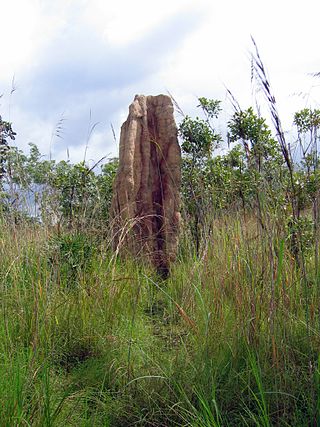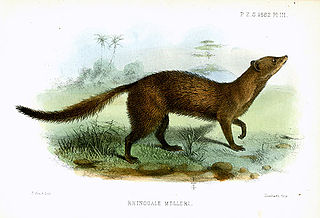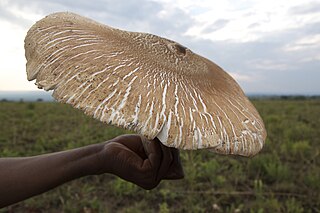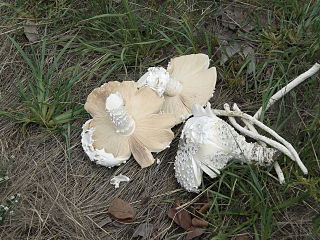
Termites are a group of detritophagous eusocial insects which consume a wide variety of decaying plant material, generally in the form of wood, leaf litter, and soil humus. They are distinguished by their moniliform antennae and the soft-bodied and often unpigmented worker caste for which they have been commonly termed "white ants"; however, they are not ants, to which they are distantly related. About 2,972 extant species are currently described, 2,105 of which are members of the family Termitidae.

Mound-building termites are a group of termite species that live in mounds which are made of a combination of soil, termite saliva and dung. These termites live in Africa, Australia and South America. The mounds sometimes have a diameter of 30 metres (98 ft). Most of the mounds are in well-drained areas. Termite mounds usually outlive the colonies themselves. If the inner tunnels of the nest are exposed it is usually dead. Sometimes other colonies, of the same or different species, occupy a mound after the original builders' deaths.

Meller's mongoose is a small brown mongoose native to savannas and woodlands of southeastern Africa. It is the only member of the genus Rhynchogale. The Meller's mongoose lives alone and is active at night, feeding on termites or other small insects and animals. While somewhat rare, it is adaptable and faces no serious threats. It is a member of the mongoose family (Herpestidae), a group of fox-like animals native to Asia, southern Europe, and Africa.
Alchornea floribunda is a plant native to tropical Africa. The plant is locally known as Niando.

The Macrotermitinae, the fungus-growing termites, constitute a subfamily of the family Termitidae that is only found within the Old World tropics.

Termitomyces titanicus is a species of fungus in the Lyophyllaceae family. Found in West Africa, it has a cap that may reach 1 metre (3 ft) in diameter on a stipe up to 22 inches (57 cm) in length. Termitomyces is symbiotic with termites of the genus Macrotermes who raise the hyphae upon partially digested leaves as their primary foodstuff. T. titanicus was unknown to Western science prior to 1980, even though it was a common item in the native markets. Pegler and Piearce made no attempt to explain its late discovery.
J. Scott Turner is an American physiologist who has contributed to the theory of collective intelligence through his fieldwork on the South African species of termite Macrotermes michaelseni, suggesting the architectural complexity and sophistication of their mounds as an instance of his theory of the extended organism or superorganism. His theory was reviewed in a range of journals, including Perspectives in Biology and Medicine, the New York Times Book Review, EMBO Reports, and American Scientist.

Macrotermes bellicosus is a species of Macrotermes. The queens are the largest amongst known termites

Termitomyces schimperi is a large mushroom associated with the termite species Macrotermes michaelseni. It grows in the northern part of Southern Africa, from northern Namibia up to Democratic Republic of Congo (DRC), eastwards to Malawi and Mozambique, and westwards to Ivory Coast.

Termitotrox cupido is a species of scarab beetle in the subfamily Termitotroginae. It was first described by Munetoshi Maruyama in 2012, having been discovered living inside a nest of the termite Hypotermes makhamensis in Cambodia. It is a tiny, blind and flightless insect.
Hypotermes makhamensis is a species of termite in the subfamily Macrotermitinae of the family Termitidae. It lives in dry evergreen forests in tropical south-eastern Asia and builds termite mounds in which it cultivates fungus for use as food.

Macrotermes michaelseni is a species of termite in the family Termitidae, found in sub-Saharan Africa. It is associated with the fungus Termitomyces schimperi.

Macrotermes is a genus of termites belonging to the subfamily Macrotermitinae and widely distributed throughout Africa and South-East Asia. Well-studied species include Macrotermes natalensis and M. bellicosus.
Macrotermes convulsionarius is a species of termite of the family Termitidae. It is native to India and Sri Lanka. Soldiers are very large with well developed mandibles. It is a major pest of many wood works in buildings. Flagellated bacteria such as Bacillus, Acinitobacter, Salmonella, Enterobacter, and Enterococcus are found abundant in gut of M. convulsionarius.
Dysgonomonas macrotermitis is a Gram-negative, facultatively anaerobic and non-motile bacterium from the genus of Dysgonomonas which has been isolated from the hindgut from the termite Macrotermes barneyi.

Macrotermes carbonarius, also known as Kongkiak in Malay, is a large black species of fungus-growing termite in the genus Macrotermes. It is one of the most conspicuous species of Macrotermes found in the Indomalayan tropics, forming large foraging trails in the open that can extend several metres in distance. M. carbonarius is a highly aggressive species with the soldiers possessing large curving mandibles that easily break skin. It is found in Cambodia, Malaysia, Myanmar, Singapore, Thailand and Vietnam.

Macrotermes natalensis is a fungus-growing termite species that belongs to the genus Macrotermes. This species is associated with the Termitomyces fungal genus. M. natalensis has domesticated Termitomyces to produce food for the colony. Both termite species- fungal genus- are obligate and mutually beneficial where termite relies on the fungus to break down for plant materiel and nutrient resource. In contrast, the fungal species obtain plant material and optimal conditions for growth.

Odontotermes is a termite genus belonging to subfamily Macrotermitinae, which is native to the Old World. They are most destructive in wooden homes, and are agricultural pests in the tropics and subtropics of Africa and Asia. It is the most diverse termite genus in Africa, with 78 species recorded.
Streptomyces smaragdinus is a Gram-positive bacterium species from the genus of Streptomyces which has been isolated from the gut of the termite Macrotermes natalensis.











